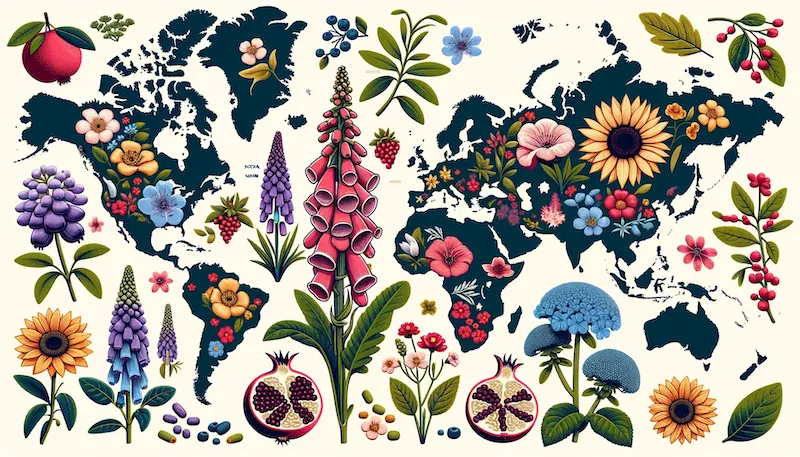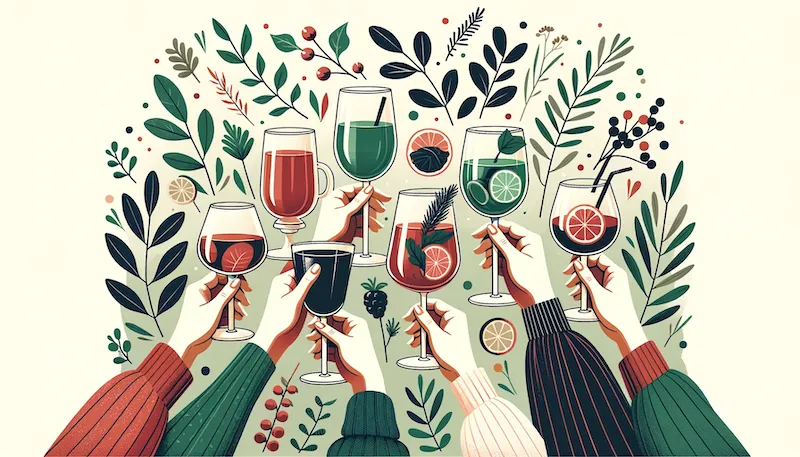Gin has danced its way across history, leaving an indelible mark on cultures, palates, and imaginations worldwide.
Whether you’re a seasoned gin enthusiast, a curious newcomer, or someone eyeing that fancy bottle as a potential gift, there’s an undeniable mystique to this clear spirit.
Gin primarily tastes of juniper berries, which impart a fresh, pine-like flavor reminiscent of a forest after a rain. Its profile is often complemented by a variety of botanicals, ranging from citrus peels and coriander to floral and spice notes.
The exact taste can vary based on the type of gin and its botanical blend, but most gins strike a balance between herbal, citrusy, and earthy flavors, resulting in a crisp, aromatic, and refreshing spirit.
Dive in with me as we explore the tantalizing world of gin, from its history and flavors to its cultural significance and beyond.
A Quick Sip Down Memory Lane
Gin’s journey is as captivating as its flavor. Its roots trace back to the medicinal concoctions of ancient civilizations, where distilled spirits were infused with herbs for healing purposes. However, gin as we know it today began its tale in Europe.
In the Middle Ages, the Dutch produced a spirit called “jenever” (or “genever”), which can be considered gin’s older cousin. Initially used as medicine, jenever gained popularity as a drink during the Eighty Years’ War, where Dutch soldiers consumed it for its warming and courage-boosting properties, giving rise to the term “Dutch Courage.”
Fast forward to 18th-century England, and gin was the star of its own dramatic episode: the Gin Craze. Thanks to lenient production regulations and heavy taxation on imported spirits, gin production exploded. It was affordable, widely available, and in some cases, more accessible than clean water. While this period had its dark side — with overconsumption leading to societal issues — it also laid the foundation for gin’s entrenchment in British culture.
Over time, the once rudimentary and harsh spirit underwent refinements, evolving into the sophisticated drink I cherish today. Its transformation is a testament to humanity’s quest for perfection in taste and experience.
The Backbone of Gin

If gin had a heart, it would undoubtedly be the juniper berry. This small, dark blueberry, often mistaken for a seed, is what gives gin its distinct and signature flavor. Without it, gin wouldn’t be gin at all; in fact, the very name “gin” is derived from the Dutch word “jenever” and the French word “genièvre,” both meaning juniper.
So, what does the juniper berry bring to the table? Think of a walk through a dense, aromatic pine forest; that fresh, slightly resinous scent is reminiscent of juniper. It’s no surprise that many first-time gin drinkers liken the spirit’s taste to a “Christmas tree.” But juniper offers more than just a piney punch. Its flavor is complex, encompassing elements of sweetness, bitterness, and a slight peppery finish.
While juniper remains the primary and non-negotiable ingredient, it’s the orchestra of other botanicals that make each gin unique. From citrus peels and angelica root to more exotic ingredients like lavender and grapefruit, each botanical adds its own voice to the symphony, creating a harmonious blend of flavors that dance on the palate.
Navigating the World of Gin Flavors
Gin’s diverse landscape offers a variety of styles, each providing a unique taste experience. As I immerse myself in its vast world, I’ve discovered that each type of gin speaks its own flavorful language. Here’s a breakdown of the most celebrated gin styles, accompanied by a flavor comparison to help you relate:
London Dry Gin
This is the classic. It’s like the crisp white shirt in your wardrobe – versatile and timeless. Predominantly juniper-forward, imagine biting into a fresh Granny Smith apple while walking through a pine forest. It’s sharp, clean, and aromatic, with no added sugars post-distillation.
Plymouth Gin
Exclusively made in Plymouth, England, this gin offers a slightly earthier, softer juniper profile. Picture a boat ride on a calm, misty morning – it’s smooth with a subtle maritime touch, thanks to a unique blend of botanicals.
Old Tom
The sweet-talker of the gin world. Drinking Old Tom is like enjoying a slice of honey-drizzled toast. It’s richer and sweeter than the London Dry, creating a harmonious balance between botanicals and added sweetness.
Sloe Gin
A red-hued, berry-infused delight. Imagine sipping on a tart berry tea with a hint of almond on a cozy winter evening. Made by steeping sloe berries in gin and adding sugar, it’s more a liqueur than a gin, boasting a balance of sweet and tart.
Barrel-Aged Gin
Taking inspiration from the whiskey world, imagine the comforting embrace of a soft woolen blanket. The oak barrel aging introduces flavors of vanilla, caramel, and wood, offering a warmer, cozier gin experience.
Genever
The historical heavyweight. Drinking Genever is akin to enjoying a piece of rustic, grainy bread. Its malty character sets it apart from its botanical-driven cousins, harking back to gin’s early roots.
Distinguishing between these styles offers more than just knowledge; it’s a sensory journey. Recognizing the nuances in each gin type can elevate your drinking experience, whether you’re sipping it neat or crafting a cocktail.
Science in Every Sip
The taste of gin isn’t just about the ingredients; it’s a marriage between art and science. At the heart of this science is the distillation process. It’s where the raw materials transform, capturing the very essence of the botanicals.
Here’s a simplified snapshot of how the magic happens:
Maceration
This is where the journey begins. Botanicals are steeped in a neutral grain alcohol, much like how you’d let tea leaves steep in hot water. This allows the flavors to infuse into the alcohol.
Distillation
The alcohol, now laden with the flavors from the botanicals, is heated in a still. As it heats up, vapors rise, carrying with them the concentrated flavors. These vapors are then cooled and condensed back into liquid form.
Collecting the Heart
Distillation isn’t a one-size-fits-all process. The beginning of the distillation, known as the “heads,” contains unwanted alcohol. The end, termed the “tails,” also has components that aren’t ideal for gin. It’s the middle portion, the ‘heart,’ that contains the purest and most flavorful spirit. Think of it as skimming the cream off the top; it’s the best part!
Dilution
The distilled spirit, which is high in alcohol content, is then diluted with water to reach the desired strength.
Resting
Some gins are allowed to rest post-distillation, letting the flavors meld together harmoniously.
The process might sound technical, but it’s this very science that gives gin its character. Each distillery has its own methods, still shapes, and chosen botanicals, which means every gin tells its own tale of craftsmanship and precision.
Gin Around the Globe

Gin, while rooted in European traditions, has blossomed into a global affair. As it journeyed across continents, it absorbed the flavors and sensibilities of diverse cultures, resulting in a plethora of gin styles that are as varied as the countries they hail from.
England: The birthplace of the modern gin we recognize today. English gins, particularly London Dry, have a clean, sharp profile where juniper takes center stage. It’s like the refreshing drizzle on a cool British morning.
Scotland: Known for its whisky, Scotland has also made a significant mark on the gin world. Scottish gins often incorporate local botanicals, such as heather and seaweed, reflecting the rugged beauty of its landscapes.
Spain: In Spain, gin is often enjoyed in the form of a ‘Gin-Tonic,’ served in large balloon glasses with an array of garnishes. Spanish gins might feature botanicals like citrus, olives, or almonds, echoing the country’s vibrant culinary palette.
America: The New World has embraced gin with open arms, leading to the rise of ‘New Western’ or ‘American Contemporary’ gins. These often downplay juniper in favor of other botanicals, offering a more experimental taste—think of a jazz improvisation, where unexpected notes create a harmonious tune.
Asia: As gin gains popularity in Asia, distilleries in countries like Japan are introducing gins with unique botanicals such as yuzu, sakura flowers, and green tea, producing gins that are a delicate blend of tradition and innovation.
The beauty of gin lies in its adaptability. It’s a spirit that, while holding onto its juniper essence, effortlessly melds with the flavors and cultures it encounters, producing a rich tapestry of tastes for us to explore.
Gin & Food Harmony
Matching gin with the right food can elevate the flavors of both, turning a simple meal into a memorable experience. Whether it’s a casual get-together or a fancy dinner, understanding the nuances of gin can help you curate the perfect pairing. Here are some suggestions based on different gin types:
London Dry Gin: With its sharp, juniper-heavy profile, London Dry pairs wonderfully with salty and fatty foods. Think smoked salmon, cured meats, and strong cheeses. The gin’s crispness cuts through the fat, creating a balanced taste.
Plymouth Gin: The earthier notes of Plymouth Gin complement richer, cream-based dishes. A creamy seafood chowder or a mushroom risotto would be a delightful match.
Old Tom: Given its sweeter profile, Old Tom goes hand in hand with spicy foods. From spicy Asian curries to Mexican dishes with a kick, the gin’s sweetness can tame the heat while enhancing the spices.
Sloe Gin: Its berry-infused nature makes Sloe Gin a dessert lover’s dream. Pair it with fruit tarts, chocolate mousses, or even a simple bowl of mixed berries drizzled with cream.
Barrel-Aged Gin: This gin’s warm, woody undertones are a match made in heaven with grilled meats. Be it barbecued ribs or a well-seared steak, the gin’s flavors accentuate the char and smokiness.
Genever: Its robust, malty character finds a friend in starchy foods. Think potato gratin, hearty stews, or even crispy fries.
Remember, while these are tried-and-true pairings, the world of gin and food is vast and open to experimentation. Trust your palate, and don’t be afraid to venture outside the box. After all, the best discoveries often come from uncharted territories.
Tips for Refining Your Gin-Tasting Skills
Gin, with its intricate web of flavors, offers a delightful playground for the senses. Whether you’re new to the world of gin or a seasoned enthusiast, refining your tasting skills can elevate your appreciation for this versatile spirit. Here are some tips to guide you on your gin-tasting journey:
- Start Neat: Before diving into cocktails or mixers, try the gin neat. It allows you to experience its pure essence without distractions. Just a small amount in a glass can reveal a lot about its character.
- Use the Right Glassware: A tulip-shaped glass or a copita, with its inward-curving top, is ideal. It concentrates the aromas, letting you pick up the subtle notes.
- Nose Before You Sip: Our sense of smell greatly influences taste. Gently swirl the gin in your glass, take a moment to inhale deeply, and identify the prominent botanicals. Is it floral? Fruity? Spicy?
- Sip Slowly: When tasting, let the gin coat your palate. Try to identify the various flavor stages – the initial taste, the mid-palate, and the finish. Each stage might reveal different notes.
- Add a Drop of Water: It might sound counterintuitive, but a drop or two of water can open up the gin’s flavors, making them more pronounced and easier to identify.
- Keep Notes: Especially if you’re trying different gins, jotting down your impressions can be invaluable. Over time, you’ll recognize patterns in your preferences, helping you select gins you’re likely to enjoy.
- Pair with Food: As we discussed earlier, pairing gin with the right food can amplify its flavors. Use these pairings as a guide to discern the gin’s characteristics.
- Stay Curious: The world of gin is vast and ever-evolving. New distilleries, innovative techniques, and unique botanicals mean there’s always something new to try.
Remember, like any skill, gin tasting requires practice and patience. Each tasting session offers a learning opportunity, and over time, you’ll develop a keen sense for the nuances that make gin such a fascinating spirit.
Conclusion

Our journey through the aromatic alleys and historic highways of gin is akin to exploring an ancient city, rich with stories and flavors waiting to be discovered. From its humble origins as a medicinal remedy to its rise as a global spirit celebrated in bars and homes alike, gin is truly a drink that transcends time and boundaries.
The beauty of gin lies not just in its versatility but in its ability to connect us — to cultures, traditions, and each other. Whether you’re savoring a classic London Dry on a quiet evening, experimenting with a cocktail, or exploring a new gin from a distant land, each sip tells a story.
And while the juniper berry remains gin’s beating heart, it’s the myriad of botanicals, the alchemy of distillation, and the passion of distillers that give it a soul. It’s an invitation to travel, to experience, and to savor.
For those new to gin, welcome to a world of endless possibilities. For the enthusiasts, may your passion and curiosity never wane. And to everyone, here’s to shared moments, delightful discoveries, and the timeless spirit of gin.
Thank you for accompanying me on this gin-laden journey. May your glasses always be full and your spirit ever curious. Cheers!
